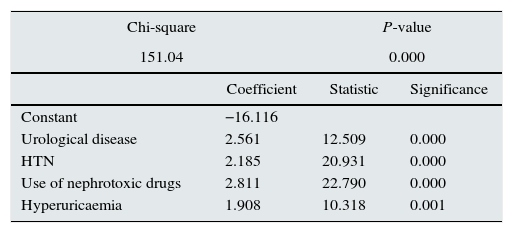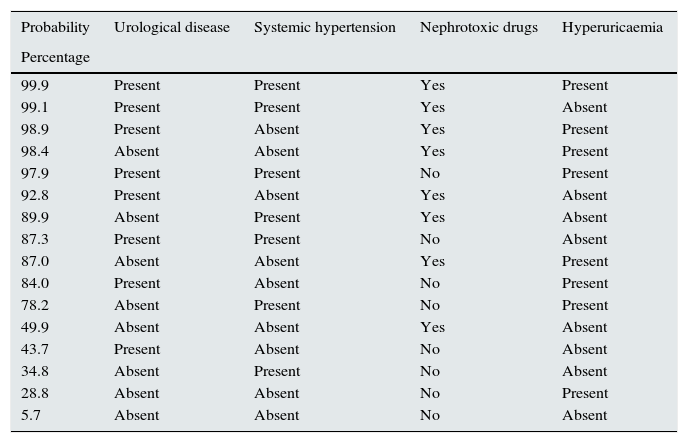The 2014 Spanish agreement Document for the Detection and Management of Chronic Kidney Disease (CKD) recommended that, in people with risk factors for development of and progression of CKD, the doctor should take certain preventive measure.1
Despite these recommendations, the prevalence of CKD continues to rise. In Mexico, one of the Latin American countries with the highest prevalence of CKD,2,3 there was an increase from 394 to 986 (patient per million)ppm from 2003 to 2007.
To help primary care physicians to monitor groups at risk, a model was constructed to predict probability of developing CKD, depending on the different combinations of risk factors that can be detected in a family medicine clinic.
This was a case–control study of patients treated in a primary care unit of the Instituto Mexicano del Seguro Social (Mexican Social Security Institute), Querétaro, Mexico, in 2013. The sample size was calculated using the formula for two proportion, with a significance level of 95%, test power 80%, OR 2.2, considering a 1:1 ratio of patients with CKD for unpaired data (n=100 for each group).
Definition of groupsCases: patients diagnosed with CKD by the renal department, glomerular filtration rate ≤60mL/min, measured by 24h urinary creatinine clearance, both sexes, and those older than 18 years.
Controls: patients without CKD, glomerular filtration rate ≥61mL/min measured by the Cockcroft–Gault formula on 2 different occasions and confirmed by a 24h urinary creatinine, both sexes, and those older than 18 years.
Exclusion criteria were pregnancy and other causes of proteinuria. Patients with incomplete histories were not included.
Cases were chosen using simple random sampling, and controls were chosen by non-probability quota sampling. The risk factors established by the Spanish agreement Document for CKD susceptibility, onset, and progression were taken into account for the analysis, and only those that reached statistical significance were included in the model. The variables of sex and age were not included, because they were part of the formula used to estimate glomerular filtration rate.
A Chi-square test was used to estimate the risk of odds ratio (OR). Logistic regression analysis was used to construct the model, with a method of progressive inclusion of variables, including those that reached statistical significance, with a 95% confidence level.
A probability risk analysis was performed, based on the frequency of CKD with different combinations of the variables that were found to be significant risk factors, expressed as percentages. The formula 1/(1+e−y) was used for this calculation.
The risk factors that could be used, due to their strong association, to create the model were urological diseases, systemic hypertension (HTN), hyperuricaemia, and use of nephrotoxic drugs. Nephrotoxic drugs had the strongest association (Table 1). According to this model, there is a 99.9% probability of developing CKD if a patient has all 4 risk factors. If a patient has a urological disease and uses long-term nephrotoxic drugs, the probability is 92.8% (Table 2).
Multiple logistic regression model to explain chronic kidney disease.
| Chi-square | P-value | ||
|---|---|---|---|
| 151.04 | 0.000 | ||
| Coefficient | Statistic | Significance | |
| Constant | −16.116 | ||
| Urological disease | 2.561 | 12.509 | 0.000 |
| HTN | 2.185 | 20.931 | 0.000 |
| Use of nephrotoxic drugs | 2.811 | 22.790 | 0.000 |
| Hyperuricaemia | 1.908 | 10.318 | 0.001 |
HTN, systemic hypertension.
The statistical analysis included a Chi-square test and the calculation of the multiple logistic regression model, with a 95% confidence interval.
Calculation of the probability of developing chronic kidney disease.
| Probability | Urological disease | Systemic hypertension | Nephrotoxic drugs | Hyperuricaemia |
|---|---|---|---|---|
| Percentage | ||||
| 99.9 | Present | Present | Yes | Present |
| 99.1 | Present | Present | Yes | Absent |
| 98.9 | Present | Absent | Yes | Present |
| 98.4 | Absent | Absent | Yes | Present |
| 97.9 | Present | Present | No | Present |
| 92.8 | Present | Absent | Yes | Absent |
| 89.9 | Absent | Present | Yes | Absent |
| 87.3 | Present | Present | No | Absent |
| 87.0 | Absent | Absent | Yes | Present |
| 84.0 | Present | Absent | No | Present |
| 78.2 | Absent | Present | No | Present |
| 49.9 | Absent | Absent | Yes | Absent |
| 43.7 | Present | Absent | No | Absent |
| 34.8 | Absent | Present | No | Absent |
| 28.8 | Absent | Absent | No | Present |
| 5.7 | Absent | Absent | No | Absent |
The statistical analysis included the calculation of the multiple logistic regression model and, later, the estimation of the probability of developing chronic kidney disease using the formula 1/(1+e−y).
Although the factors that lead to CDK1,4,5 are widely studied, the fact is that prevention of CKD onset and progression has not been achieved.3 Therefore, studies that allow the construction of practical predictive models adjusted to specific populations are of great relevance.
In this discussion, we cannot ignore the use of nephrotoxic drug; the probability of developing CKD with this risk factor alone is 49.9%; this is a preventable factor in any population. It must be mentioned that this rate is high due to the use of non-steroidal anti-inflammatory drugs (NSAIDs). This is similar to what author authors have found.6,7
In this model, urological disease was considered a significant risk factor, with a probability of 43.7%. Prostatic enlargement was the most common disease. In the Mexican population, late detection of prostatic enlargement is common, often due to men's fear of exposing their privacy during the clinical examination. This can lead to complications such as CKD.8,9
In Mexico, the leading reason for consultation in primary care is HTN, and, according to the proposed model, there is a 34.8% probability of developing CKD with this factor alone. Likewise, the strict monitoring of uric acid levels and their timely control must not be abandoned.10
In conclusion, the model that predicted the highest probability of developing CKD was that which included urological diseases, HTN, hyperuricaemia, and the use of nephrotoxic drugs.
FundingWe acknowledge the Consejo Nacional de Ciencia y Tecnología (CONACYT) (National Council of Science and Technology), through the Consejo de Ciencia y Tecnología del Estado de Querétaro (CONCYTEQ) (Council of Science and Technology of Querétaro State) and the Querétaro State Government for the support provided by the joint fund (QRO-2011-CO2-175384), and the support of FORDECy (193512).
Please cite this article as: Gallardo Vidal LS, Rodríguez Méndez AJ, Burgos Ochoa M, Martínez Martínez ML, García Solís P, Villagrán Herrera ME, et al. Utilidad de un modelo de predicción para la enfermedad renal crónica en una unidad de primer nivel de atención. Nefrologia. 2016;36:196–198.








